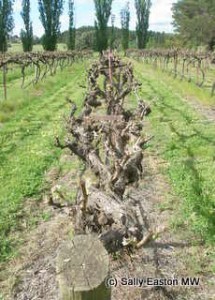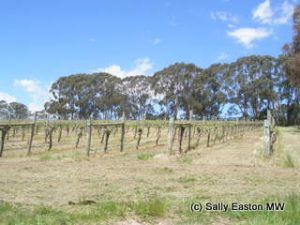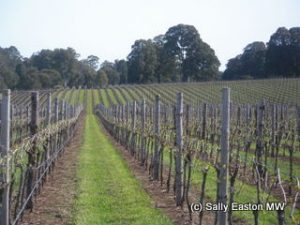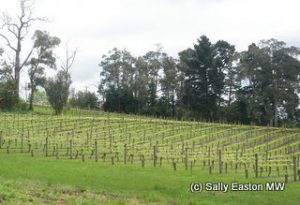The coolness of Australian wine
A version of this was first published in Drinks Business magazine, January 2011.
No-one seriously disputes that Tasmania is properly cool climate, but a slightly more confusing picture is emerging on the mainland. And with ‘cool climate’ wines being cool, trendy and of different flavour profile than ‘warm climate’, it’s too easy to let the moniker roll off the tongue without paying due regard to proper climatic data.

Canberra District, ACT
HDDs and MJTs still form the backbone of broad analytical data (see chart below), but part of the confusion in the Australian industry about cool climate may partly be due to a fairly long-standing AWBC reference to ‘warm inland’ regions, namely Riverina, Murray-Darling-Swan Hill and the Riverland, accounting for some 50% of total production, and what became known, as a matter of convenience, as ‘cool’ regions, meant to be the ‘non-warm inland’ regions, being the other 50%.
But this internal industry distinction is not an official definition and has nothing to do with climate data, and more to do with a splitting out of high cost versus low cost.
It has been modified slightly as Peter Bailey, senior analyst at AWBC explained: “We don’t use the term ‘cool’ anymore because of the confusion surrounding temperature but use ‘cool and temperate’ when the sort of high-level industry supply and demand analysis is conducted.” Given than climatic temperature zones have a scientific basis which affects viticulture and wine style, producers may mistakenly use ‘cool’ as having an official meaning.
Such internal industry nomenclature notwithstanding, there are patterns in cooler climate Australian viticulture via an enmeshed combination of climate, variety and resultant stylistic expression.
The marginality of ripening
The limit of ripening for grapes is often used as a measure of climate. What’s cool for shiraz is warm for pinot noir. And pinot noir is useful proxy of cool climate because if it’s grown somewhere too warm, it becomes, hot, blowsy, and just another red wine. To have any varietal character the aromatics and delicacy need to be retained.
On this measure, some of Australia’s most acknowledged pinot noir/cooler climate areas are coastal and maritime: Geelong, Gippsland, Mornington Peninsula, Tasmania.
Diurnals
But this is not the only story. High diurnal temperature variations, found at higher elevations, are also crucial for retaining aromatics and delicacy. Where this is combined with the 0.6°C reduction in temperature for every 100m increase in altitude, cooler climate styles emerge.

Orange region, New South Wales
At Brangayne, in Orange, owner David Hoskins said “January can go below 10°C at night. An average day time would be 26°C; a hot day here would be 32°C and really hot is 35°C.” The advantage of this, he said is that “the growing season is long, and fruit is on the vine longer, which means post-veraison flavour development is not rushed by heat. And sugar accumulation here is slower” so resulting alcohol is not so high as in warmer areas.
Added to which said Hoskins, who has vineyards at 870m and 970m, “we notice it’s worth more than 0.6C between our two properties. The lower vineyard is more open, worth at least a degree more [warmth]. On its western slope, buds burst and grapes ripen earlier than the north-east slopes” of the higher vineyard. Hoskins reckons the lower vineyard gets more warmth from the prevailing westerly weather.
In Canberra District, which varies from 300m to 800m elevation, Richard Parker of Long Rail Gully Wines said “we’re not Tassie cool, but we’re cool. We have a big diurnal, 25°C in the day to 10°C at night. Our peak summer temperature is around 32°C. These really cool nights maintain our acid. The warmer days give us a riper type character, but cooler nights bring us back.” He added the cool style is lighter in body, with more finesse and restraint of fruit character with more spice [shiraz], and alcohols held around 13.5%.
Greater natural acidity
For Phil Sexton of Giant Steps/Innocent Bystander in the Yarra Valley, those cold nights are critical to “drive low pH and therefore keep total acidity high.” As they are for Richard Thomas of Mayfield Vineyard in Orange, whose vineyards reach 870 to 920m. He said “the high diurnal[s] in the growing season maintain a natural acid backbone, which enhances flavour through gradual flavour development.”
The acidity, or acidification, question is an interesting one from a European perspective, where de-acidification is the permitted norm in EU cool climate regions.
Added to which sunshine, and its management in the vineyard, in the southern hemisphere is different to the northern, as Ron Laughton of Jasper Hill, explained, for his Heathcote region “it’s not only about heat, it’s the quality of the sun. Summer here is radiant, without so much heat – we needed a blanket on every night last summer. Shiraz needs some sun and warmth to ripen. There are some cooler areas within Victoria, where shirazes show more elegance than mine, but also less ripeness. Here we get ripe flavours and elegance. The best indicator for me is not extreme sugar ripeness, but full tannic ripeness, full flavour ripeness, and full acidity still. In 30 years I haven’t adjusted acidity. That’s the single biggest indicator that this area is great for shiraz.”
Heathcote may indeed be cooler marginal for shiraz. But it is not ‘cool climate’ by the numbers (see chart), and is a modest 200m above sea level.
Elevation and aspect – high country
Altitude is needed to get those high diurnals, but as though in recognition that the cool climate moniker is becoming muddied, ‘high country’ is becoming a term of increasingly common parlance. Indeed Orange is the only GI defined by altitude – vineyards falling over 600m.

King Valley, Victoria
One of the recent pioneers to plant in Orange was Philip Shaw, when he was working at Rosemount. He said “I was flying over here when I was looking, for Rosemount, for somewhere to plant pinot noir and chardonnay. I planted my own back in the 1980s,” at 900m. He added “At 600m it was looking something like southern France, Spain and Italy. Higher up it was looking more like Champagne.”
The King Valley also reflects such dramatically changing climate by altitude. Its 150m altitude north end is notably warm at Milawa, while the 800m Whitlands plateau at its southern end, just some 25 km distant, nudges the foothills of the Australian Alps. Brown Brothers long ago saw the potential of this higher altitude, establishing the Whitlands vineyard in 1982 specifically for fruit for sparkling wines, of which there were none in their range at that time.
The significance of altitude was recognised last year by one of Australia’s three ‘cool climate’ wine shows. The entry requirements for the International Cool Climate wine show in the Mornington Peninsula state “wines must be made from grapes grown either: south of latitude 37.5 degrees south, or north of latitude 37.5 degrees north, or from a property in the southern or northern hemisphere which has an average January/ July (whichever is applicable) temperature below 19° Celsius, as confirmed by the nearest Bureau of Meteorology site, or vineyard site is above 800m in altitude.”
The 19°C limit is stricter than Winkler Region I, but, said Meg Brodtmann MW, of Southern Cross Wines, who chaired the competition in 2010 said “the altitude was introduced in 2010 as they were missing out on a lot of cool climate wines based solely on latitude and MJT.” She emphasised “newer regions of Australia are cooler once you go up a bit.”
Another benefit is that the growing season is delayed, so that grapes are not ripening at the hottest point. Alan Cooper of Cobaw Ridge, with vineyards up to 635m, in the Macedon Ranges said “shiraz can be around six weeks behind central Heathcote, yet you can drive there in 25 minutes” before explaining “cool climate shiraz is black pepper spicy, savoury, minerally, earthy, graphite. It could be spicy on the nose and peppery on the palate, or the other way round.”
Similar cool climate style comments are replicated in Canberra District, where Brindabella Hills’ Roger Harris said of shiraz, cool climate brings “an attractive perfume of violets, in a style that is not heavy and weighted down with a load of tannin; it’s not relying on weight and power, more seductive. You want to have another glass of it.“

Lower Yarra Valley
And in the Lower (higher altitude) Yarra Valley an extra couple of weeks are required for ripening compared to the valley floor 230 to 250m below. The advantage, said Mac Forbes of Mac Forbes Wines, of “picking at least 10 days later, is that the cooler sites have a slower ripening, with a greater retention of aromatics”, another one of those experientially defining parameters for cooler climate. In addition, Forbes gets his chardonnay from southern slopes (facing away from the sun), to “retain freshness and line” he said.
A southerly aspect was an important decision for Savaterre’s Keppell Smith, a specialist in chardonnay and pinot noir, whose chardonnay has been listed in the latest Langton’s. He said his Beechworth “vineyards face south on sloping ground to avoid the frosts, which fall down the slope.” But, he added “the sun’s still strong, so I have at least one layer of leaves.”
Beechworth vineyards stretch from around 400m to 550m. Slopes are important as frost is an issue, and it is the more altitudinally-forgiving chardonnay that has excelled in this region of passion-driven individuals, where Giaconda’s vineyards are at 400 to 420m, on the opposite side of the road to those of Savaterre.
Whether the drive is towards the Antarctic or into the high country, cool and cooler climate results in wines significantly different from Australia’s previous models. Mayfield’s Thomas sums it up as “cool climate has less density, it has more fruit expression, more elegance and finesse, it’s less overpowering and more complimentary with food.” Do we begin to arrive at nuance, not a word yet commonly encountered in a Pom’s caricature of Aussies?
| HDDHeat degree days | MJT mean Jan / July temperature | altitude | Winkler | harvest | |
| Tasmania |
1020 |
17.2 |
80 to 210 |
1 |
Early April to late May |
| Adelaide Hills |
1270 |
19.1 |
400 to 500m |
1 |
Early April to late May |
| Tumbarumba |
1010 |
19.3 |
300 to 800m |
1 |
Early Mar to early May |
| Eden Valley |
1390 |
19.4 |
380 to 550m |
1 |
Mid Mar to Early May |
| Orange | 1200 to 1309 |
19.9 |
600 to 900m |
1 |
Mid March to early May |
| Macedon | 970 to 1050 | 17.2 to 18.5 | 300 to 700m |
1 |
Mid March to early June |
| Yarra Valley | 1250 to 1352 | 17.9 to 19.4 | 50 to 400m |
1 |
Early March to early May |
| Denmark (Great Southern) |
1470 |
18.7 |
50 to 150m |
1-2 |
Early March to late April |
| Frankland River |
1441 |
19 |
200 to 300m |
1-2 |
Mid March to mid April |
| Geelong |
1470 |
19 |
20 to 150m |
1-2 |
Early March to end April |
| Coonawarra |
1430 |
19.6 |
60m |
1-2 |
Early March to end April |
| Gippsland | 1300 to 1470 | 18.1 to 19 | 20 to 50m |
1-2 |
Early Mar to end April |
| Mornington Peninsula | 1080 to 1570 | 18.8 to 20 | 25 to 250m |
1-2 |
End March to early June |
| Beechworth | 1240 to 1687 | 19.9 to 20.4 | 300 to 720m |
1-2 |
Mid March to end April |
| King Valley | 1350 to 1580 | 20.8 to 22 | 155 to 850m |
1-2 |
Early March to late April |
| Canberra District |
1410 |
20.2 |
500 to 850m |
2 |
Mid March to end April |
| Granite Belt |
1602 |
20.6 |
810m |
2 |
End Feb to mid April |
| Strathbogie Ranges |
1460 |
20.7 |
2 |
Mid March to mid-May | |
| Heathcote |
1490 |
21 |
160 to 320m |
2 |
Mid March to early May |
| Margaret River |
1690 |
20.4 |
40m |
3 |
End Feb to mid April |
| Barossa |
1710 |
21.4 |
250 to 370 |
3 |
End Feb to late April |
| McLaren Vale |
1910 |
21.7 |
50 to 200m |
3 |
Feb to late April |
| Clare Valley |
1770 |
21.9 |
400 to 500m |
3 |
Feb to April |
| Rutherglen |
1770 |
22.3 |
170m |
3 |
End Feb to early May |
| Hilltops |
1880 |
22.5 |
450m |
3 |
Late March to may |
| Murray-Darling |
2150 |
23.7 |
55 to 70m |
4 |
Late Jan to mid March |
Source: Wine Australia
Comments
3 Responses to “The coolness of Australian wine”




April 6, 2011 at 2:19 am
An excellent story raising very important and relevant issues. The only disappointing thing to note is that Tasmnia is lumped into one category, when there are in fact, 4 seperate regions that all have vastly different GDD, MJT and elevations.
April 6, 2011 at 8:21 am
Thanks for your comment Fiona, glad you liked the story. My piece was focusing on the ‘north island’, and, within the constraints of word count that print publications have, I wanted to mention, succinctly, that all of Tasmania is cool, before going on to discuss issues on the mainland. It’s great that there are different regions in Tas. Is there any work going on to split up the one GI that you’ve got into those four regions you mention? That sounds like another good story. I clearly need to come back for another visit!
April 26, 2011 at 4:25 pm
Interesting article Sally
My impression is that Australia, having given the world ripe, oaky Chardonnays, seems to be having a crisis of confidence about what to do next and has lurched towards cool-climate-style whites as a result.
I first noticed this at a tasting earlier this year:
http://cambridgewineblogger.blogspot.com/2011/03/australian-tasting-with-noel-young.html
and also at the Matthew Jukes tasting a few weeks later:
http://cambridgewineblogger.blogspot.com/2011/04/matthew-jukes-100-best-australian-wines.html
Cheers, Tom